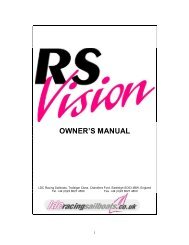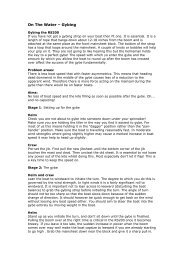rs200 owner's manual - Rs Sailing
rs200 owner's manual - Rs Sailing
rs200 owner's manual - Rs Sailing
Create successful ePaper yourself
Turn your PDF publications into a flip-book with our unique Google optimized e-Paper software.
3. Damage<br />
Hull damage falls into three categories:<br />
a) SERIOUS e.g. large hole, split, crack or worse. Don't be too distressed!<br />
Get the remains back to your RS dealer, most problems can be repaired by<br />
the builder.<br />
b) MEDIUM e.g. small hole or split, gel crazing. If this occurs during an event,<br />
sailing can often be continued, as long as leaking can be prevented by drying<br />
off the area and applying a strong adhesive tape. Sail repair tape, duck tape<br />
or "denso" tape works well with the ends of the tape cut to a radius to prevent<br />
the corners peeling back. CAUTION - if the damage has occurred on or close<br />
to a heavily loaded point, then a close inspection should be made to ensure<br />
joints or laminate are fit for the prevailing conditions. If in doubt, ask an RS<br />
dealer. With this type of damage, get it fixed as soon as possible at your local<br />
RS dealer.<br />
c) SMALL e.g. chip, scratching. This type of damage is obviously not life<br />
threatening but needs to be attended to, firstly to keep the boat looking good<br />
and secondly to prevent water ingress into the laminate.<br />
This type of damage can be rectified by you the owner, if you wish. Buy the<br />
correct colour gel coat repair kit from your RS dealer and either wait for a dry<br />
warm day outside or preferably put your boat in a dry warm place under<br />
cover. Start by carefully drying the area to be repaired.<br />
N E A T N E S S A N D C A R E<br />
I S T H E S E C R E T O F A<br />
G O O D R E P A I R !<br />
If the damage is a single scratch or score mark, make sure it is clean by<br />
gently re-scratching with the tip of a sharp craft knife. If the damage is more<br />
general, etch up with a medium grade abrasive - say 80 grit (no wet or dry<br />
paper because it will leave a grey discoloration). Blow off the dust, don't wipe;<br />
this may leave fluff or contamination which will spoil the quality of the repair.<br />
If your hand is not steady, mask around the prepared area with masking tape<br />
(always remove the tape while the gel coat is liquid)<br />
The gel coat you get from the dealer has a wax additive in it so, when it cures,<br />
a tack free surface is produced. This tack free surface makes final shaping<br />
and finishing of the repair easier but also means that if you have to recoat the<br />
repair, the surface should be abraded or solvent wiped to remove the paraffin<br />
wax which helps create the tack free surface.<br />
Stir the tin of gel coat, then decant a small quantity into a suitable container<br />
and add 2% catalyst. As a guide use 2 drops of catalyst (match head size) per<br />
full tin lid measure from an RS gel coat tin. Mix thoroughly and carefully apply<br />
to the repair area with a suitable instrument e.g. artist's brush, cocktail stick,<br />
match stick etc.<br />
18




